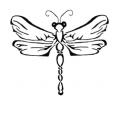Results 11 to 20 of 69
-
09-30-2014, 04:31 PM #11
Yes I completely agree on the "bloopy-ness".
 So just to clarify my understanding- when you are bridging and it droops down the material is staying hot too long and needs to harden up quicker so I can either add fans, decrease temps or increase the speed during that section. Or possibly combinations of those. I will be working with temps first- since those are easiest for me to tweak. I havent tried a print where I adjusted the speed manually during different sections ( I am assuming you can do that?) so i will have to learn that next. So much to learn! It's so much fun though! I can't even believe how much I'm enjoying this. I literally cannot wait to get home and play.
So just to clarify my understanding- when you are bridging and it droops down the material is staying hot too long and needs to harden up quicker so I can either add fans, decrease temps or increase the speed during that section. Or possibly combinations of those. I will be working with temps first- since those are easiest for me to tweak. I havent tried a print where I adjusted the speed manually during different sections ( I am assuming you can do that?) so i will have to learn that next. So much to learn! It's so much fun though! I can't even believe how much I'm enjoying this. I literally cannot wait to get home and play. 
Yes! That see-saw effect is what makes it tricky. I agree leveling should not be that time consuming. Or at least once you have a relatively level bed. Now it's not taking me long at all. Just tiny little tweaks here and there. I think in my inexperience I had gotten it pretty screwed up. Hopefully I will know better next time. I can tell I am getting a "feel" for it. And I think that's half the battle.
-
09-30-2014, 05:47 PM #12Means getting it level. :-)Now, when you (and others) say make sure the bed is "calibrated"- does that mean leveling? Or something else?
My printer has four levelling knobs. And as jfkansas says - it doesn't take more than a minute or two. And i don't do it that often.
I've come back from the tct show with a bed coating that I will try before revealing. As genuine as the 3dpunlimited people were - I'm still not entirely convinced this bed coating isn't a windup for the englishmen.
That said, they use a 1meter square glass print bed and there definitely wasn't anything visible on it. And they have to keep prints flat and stuck to the bed for days at a time so they are definitely using something better than the norm. Even so, it's that off the wall, I have to try before telling :-)
But stay tuned to be potentially blown away by something really bizarre :-)
Nope weirder than even that very weird thing you just thought of.
-
10-01-2014, 07:28 AM #13
Yes, you got it.

Adjusting speed during different sections depends on the software: some can increase/decrease speed and/or extrusion rate during bridging (and then you can of course define what the software should see as a 'bridge'.
Other software allows you to create different processes for sections, thus allowing to create a section with a different speed.
If you do a lot of gcode editing you can probably do even more.. but I cannot confirm this. I only have experience with the above - but even that (changing speed/temp during a build) is not something you have/want to do often, because it's a lot of experimenting and doesn't necessarily give better results.
I currently have two setting-profiles; one for parts with infill and one for hollow parts. I open them and adjust some settings depending on the print, save it to SD, and start the build. (assuming my bed is level)
But I agree, it's a lot of fun to play with and there's is a lot to learn and even a lot to experiment in areas that others didn't dig that deep in yet.
-
10-01-2014, 11:47 AM #14
-
10-01-2014, 01:15 PM #15
lol well i can say categorically it does not work for abs.
I will try it with pla - as it did create a sticky surface, just not for abs.
I still think it was a wind up :-)
-
10-03-2014, 01:04 AM #16
I see some use Freeze Spray to make models come off more easily, anyone got some experience with it?
-
10-03-2014, 08:19 AM #17
I use 0.2mm thick wall paper smoother/scraper from poundland to get prints off. never had any issues.
You actually get 4 of different sizes for a whole £1 :-)
Also means I don't have to change the blue tape more than every couple of weeks.
-
10-03-2014, 02:40 PM #18
If you go to home depot or lowes, they have drywall knifes that are "full flex". These work great since you can flex them flat and slide easily under a print with less chance of tearing tape.
-
10-03-2014, 10:58 PM #19
Yep, full flex knife is the way to go. I use a Stanley knife, but I extend it all the way out, those separating blades are really flexible.
Glad to hear you are going well with it Serena, I've not said much in this thread, these guys prob have more experience than me with the Flashforge X, there does seem to be a fair amount different between those and the old one I've got.
As for stick, sorry, for me can't beat blue tape and PLA now...
Out of 3 machines, a kossel, prusa and FF, I get the same exact result with my PLA now and that is dead flat prints that will stick forever unless you pry them off..
Totally non heated bed, 200c nozzle and blue tape on glass ... and if there is ever a stick issue, I use a kids glue stick on the blue tape before printing. Best stuff ever. Best way to get zero corner lift from your prints all the way through the print.
-
10-04-2014, 10:16 AM #20
Cool. Keep us updated.

I will definitely check that out- thanks for the tip! Especially since last night I tore my tape wedging a print off. Grrr.... retaping that kapton is something I really don't enjoy doing.
I have learned tons from the tips you've given on this forum- you have been a big help all ready. I haven't tried PLA yet but I'm thinking I really want to soon. In my early researching it seemed like many thought ABS was trickier to get nailed down and PLA was a bit easier. Not sure if that's really true or not. But my thinking was to start with the hardest and go from there. Of course, that thinking tends to get me in trouble! ;-) I know I will be printing a lot of cookie cutters and those do better with ABS so they can be put in dishwasher. (Which i tested and it didn't melt-yay!) But I feel like PLA has better colors, and I would much prefer working with blue tape than kapton which is ridiculously easy to tear and a pain to put on without bubbles.
I haven't tried PLA yet but I'm thinking I really want to soon. In my early researching it seemed like many thought ABS was trickier to get nailed down and PLA was a bit easier. Not sure if that's really true or not. But my thinking was to start with the hardest and go from there. Of course, that thinking tends to get me in trouble! ;-) I know I will be printing a lot of cookie cutters and those do better with ABS so they can be put in dishwasher. (Which i tested and it didn't melt-yay!) But I feel like PLA has better colors, and I would much prefer working with blue tape than kapton which is ridiculously easy to tear and a pain to put on without bubbles.
The last couple of days I have been focusing on the design aspect of the process, and that has it's own GIANT learning curve. I'd like to ask- what is everyone's prefered software choice for creating a 3D model? I've been doing graphic design for 12 years, and I thought that 3D modeling would be a natural segue from there. But it's more like trying to do everything I'm used to doing with my left hand. The whole concept is just different. I've chosen to use Blender which is a ginormous program and a bit overwhelming. I am starting to get the hang of it and I've got the basics but sometimes the littlest things can take me hours to figure out. I also thought that I would be able to use the vast amount of vectors I all ready own as a starting base for designs, or at least as some embellishments, but there doesn't seem to be a way to do that. I tried Rhino and didn't care for that, and I don't want to spend the money on Maya or 3Ds Max. Tinkercad was way to simple and doesn't let me do all my (overly) complicated ideas. As of now my workflow is modeling in Blender, checking my mesh and sizing in MeshMixer, and then Simplify3D to print. I would love to hear what other people have found works for them.






 Reply With Quote
Reply With Quote









Extruder not feeding during print,...
04-24-2024, 01:59 AM in Tips, Tricks and Tech Help